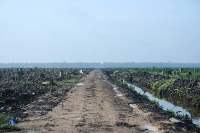Biodiversity
Latest News
A Starring Role for Nantclwyd’s Lesser Horseshoe Bats
22.05.2015
Living Landscape Brought Back to Life
05.12.2014
Facebook Page
Biodiversity under threat
The UK has lost over 100 species during the past 100 years.
Species extinction is a fact of life. Since the first life forms appeared on Earth, the fossil record has documented species evolving and dying out. In former geological times as species became extinct, new ones evolved to fill the gaps they left. However, now this is in many cases impossible as not just individual species, but whole habitats are being lost and the rate of extinction is far higher than at any previous time.
The Earth’s environment is changing more rapidly than ever before, largely due to the effects of human activity. When the human population was small and their lifestyles simple, the impact was low. As populations increased and technology developed, human needs and our ability to manipulate the natural environment increased, resulting in an even greater impact. It is over the last 200 years, particularly the last 50, that the impact has been greatest with huge losses of habitats and many species driven to extinction across the globe.
For example, more land has been converted to agriculture since 1945 than was in the whole of the 18th and 19th centuries combined. It is estimated that 90% of all large fishes have disappeared from the world’s oceans in the past half century as a result of industrial fishing activities and that 20% of corals have been lost in just 20 years, with a further 20% severely degraded. It will take hundreds of thousands of years to restore what is being destroyed in just a few decades.
The United Nations Millennium Ecosystem Assessment3, whose results were published in March 2005, concluded that humans have changed most ecosystems beyond recognition in a dramatically short space of time and the way in which society obtains its resources has caused irreversible changes that are degrading the natural processes that support life on Earth. It is thought that the rate of species extinction is now 100 – 1,000 times greater than the normal background rate and that 12% of all bird, 25% of all mammal and 32% of all amphibian species are currently threatened with extinction.
It is modern day life that poses the greatest threat to biodiversity. The rate of loss of species is greater now than at any time in history.
In Denbighshire the picture is just as bleak. Our natural environment today is poorer and more depleted than in our grandparents’ time. The need to halt this loss of biodiversity is just as important here, at this local level, as in the Amazon rainforest or the tropical reefs.
The main threats to biodiversity are:
- Habitat loss and degradation due to changes in agricultural practices, development pressure, logging, commercial forestry and so on
- Over-exploitation of natural resources such as over-fishing
- Invasive non-native species
- Human population growth
- Pollution
- Climate change

Conserving biodiversity is not only right, but vital for our future existence on this planet. We are aware that biodiversity loss is happening at an alarming rate, mainly due to the activities of humans. We are beginning to appreciate more and more the importance of biodiversity and the role it plays in maintaining the systems and processes that sustain life on Earth. However, we do not know whether and how long we can continue before these are undermined through this continuing loss. Conserving biodiversity depends on local, national and international action.



